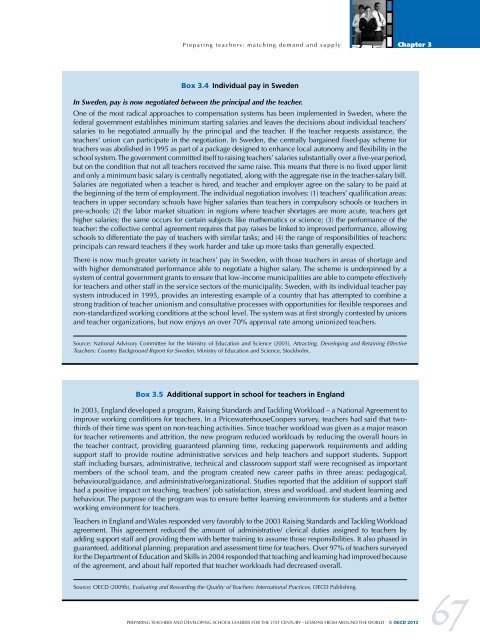Preparing Teachers and Developing School Leaders for the 21st Century
Preparing Teachers and Developing School Leaders for the 21st Century
Preparing Teachers and Developing School Leaders for the 21st Century
Create successful ePaper yourself
Turn your PDF publications into a flip-book with our unique Google optimized e-Paper software.
<strong>Preparing</strong> teachers: matching dem<strong>and</strong> <strong>and</strong> supply<br />
Box 3.4 Individual pay in Sweden<br />
In Sweden, pay is now negotiated between <strong>the</strong> principal <strong>and</strong> <strong>the</strong> teacher.<br />
one of <strong>the</strong> most radical approaches to compensation systems has been implemented in sweden, where <strong>the</strong><br />
federal government establishes minimum starting salaries <strong>and</strong> leaves <strong>the</strong> decisions about individual teachers’<br />
salaries to be negotiated annually by <strong>the</strong> principal <strong>and</strong> <strong>the</strong> teacher. if <strong>the</strong> teacher requests assistance, <strong>the</strong><br />
teachers’ union can participate in <strong>the</strong> negotiation. In Sweden, <strong>the</strong> centrally bargained fixed-pay scheme <strong>for</strong><br />
teachers was abolished in 1995 as part of a package designed to enhance local autonomy <strong>and</strong> flexibility in <strong>the</strong><br />
school system.The government committed itself to raising teachers’ salaries substantially over a five-year period,<br />
but on <strong>the</strong> condition that not all teachers received <strong>the</strong> same raise. this means that <strong>the</strong>re is no fixed upper limit<br />
<strong>and</strong> only a minimum basic salary is centrally negotiated, along with <strong>the</strong> aggregate rise in <strong>the</strong> teacher-salary bill.<br />
salaries are negotiated when a teacher is hired, <strong>and</strong> teacher <strong>and</strong> employer agree on <strong>the</strong> salary to be paid at<br />
<strong>the</strong> beginning of <strong>the</strong> term of employment. <strong>the</strong> individual negotiation involves: (1) teachers’ qualification areas:<br />
teachers in upper secondary schools have higher salaries than teachers in compulsory schools or teachers in<br />
pre-schools; (2) <strong>the</strong> labor market situation: in regions where teacher shortages are more acute, teachers get<br />
higher salaries; <strong>the</strong> same occurs <strong>for</strong> certain subjects like ma<strong>the</strong>matics or science; (3) <strong>the</strong> per<strong>for</strong>mance of <strong>the</strong><br />
teacher: <strong>the</strong> collective central agreement requires that pay raises be linked to improved per<strong>for</strong>mance, allowing<br />
schools to differentiate <strong>the</strong> pay of teachers with similar tasks; <strong>and</strong> (4) <strong>the</strong> range of responsibilities of teachers:<br />
principals can reward teachers if <strong>the</strong>y work harder <strong>and</strong> take up more tasks than generally expected.<br />
There is now much greater variety in teachers’ pay in Sweden, with those teachers in areas of shortage <strong>and</strong><br />
with higher demonstrated per<strong>for</strong>mance able to negotiate a higher salary. <strong>the</strong> scheme is underpinned by a<br />
system of central government grants to ensure that low-income municipalities are able to compete effectively<br />
<strong>for</strong> teachers <strong>and</strong> o<strong>the</strong>r staff in <strong>the</strong> service sectors of <strong>the</strong> municipality. sweden, with its individual teacher pay<br />
system introduced in 1995, provides an interesting example of a country that has attempted to combine a<br />
strong tradition of teacher unionism <strong>and</strong> consultative processes with opportunities <strong>for</strong> flexible responses <strong>and</strong><br />
non-st<strong>and</strong>ardized working conditions at <strong>the</strong> school level. <strong>the</strong> system was at first strongly contested by unions<br />
<strong>and</strong> teacher organizations, but now enjoys an over 70% approval rate among unionized teachers.<br />
source: national advisory committee <strong>for</strong> <strong>the</strong> Ministry of education <strong>and</strong> science (2003), Attracting, <strong>Developing</strong> <strong>and</strong> Retaining Effective<br />
<strong>Teachers</strong>: Country Background Report <strong>for</strong> Sweden, Ministry of education <strong>and</strong> science, stockholm.<br />
Box 3.5 Additional support in school <strong>for</strong> teachers in Engl<strong>and</strong><br />
in 2003, engl<strong>and</strong> developed a program, raising st<strong>and</strong>ards <strong>and</strong> tackling Workload – a national agreement to<br />
improve working conditions <strong>for</strong> teachers. in a Pricewaterhousecoopers survey, teachers had said that twothirds<br />
of <strong>the</strong>ir time was spent on non-teaching activities. since teacher workload was given as a major reason<br />
<strong>for</strong> teacher retirements <strong>and</strong> attrition, <strong>the</strong> new program reduced workloads by reducing <strong>the</strong> overall hours in<br />
<strong>the</strong> teacher contract, providing guaranteed planning time, reducing paperwork requirements <strong>and</strong> adding<br />
support staff to provide routine administrative services <strong>and</strong> help teachers <strong>and</strong> support students. support<br />
staff including bursars, administrative, technical <strong>and</strong> classroom support staff were recognised as important<br />
members of <strong>the</strong> school team, <strong>and</strong> <strong>the</strong> program created new career paths in three areas: pedagogical,<br />
behavioural/guidance, <strong>and</strong> administrative/organizational. studies reported that <strong>the</strong> addition of support staff<br />
had a positive impact on teaching, teachers’ job satisfaction, stress <strong>and</strong> workload, <strong>and</strong> student learning <strong>and</strong><br />
behaviour. <strong>the</strong> purpose of <strong>the</strong> program was to ensure better learning environments <strong>for</strong> students <strong>and</strong> a better<br />
working environment <strong>for</strong> teachers.<br />
teachers in engl<strong>and</strong> <strong>and</strong> Wales responded very favorably to <strong>the</strong> 2003 raising st<strong>and</strong>ards <strong>and</strong> tackling Workload<br />
agreement. this agreement reduced <strong>the</strong> amount of administrative/ clerical duties assigned to teachers by<br />
adding support staff <strong>and</strong> providing <strong>the</strong>m with better training to assume those responsibilities. it also phased in<br />
guaranteed, additional planning, preparation <strong>and</strong> assessment time <strong>for</strong> teachers. over 97% of teachers surveyed<br />
<strong>for</strong> <strong>the</strong> department of education <strong>and</strong> skills in 2004 responded that teaching <strong>and</strong> learning had improved because<br />
of <strong>the</strong> agreement, <strong>and</strong> about half reported that teacher workloads had decreased overall.<br />
source: oecd (2009b), Evaluating <strong>and</strong> Rewarding <strong>the</strong> Quality of <strong>Teachers</strong>: International Practices, oecd Publishing.<br />
Chapter 3<br />
PreParing teachers <strong>and</strong> develoPing school leaders <strong>for</strong> <strong>the</strong> <strong>21st</strong> century – lessons froM around <strong>the</strong> World © OECD 2012<br />
67


